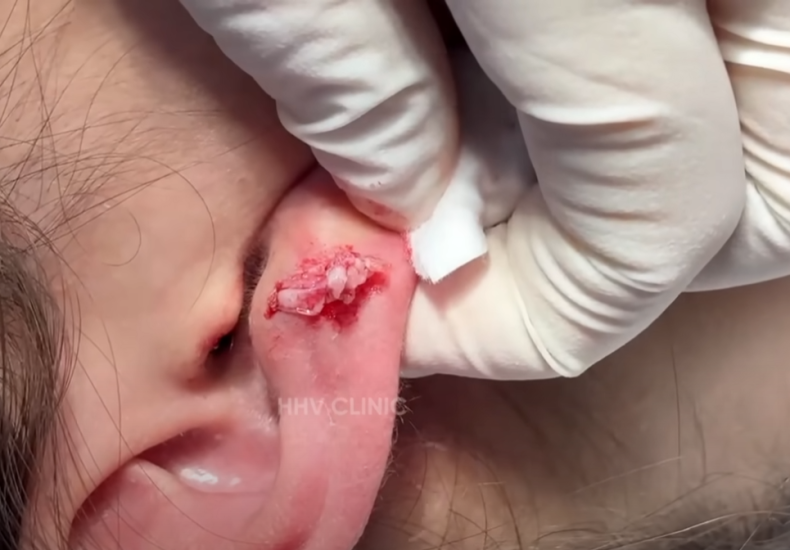
TREATMENT OF BOILERS (EAR ABSCESS) AT HHV
TREATMENT OF BOILERS (EAR ABSCESS) AT HHV
Please scroll down to watch the video.👇👇
The treatment of boilers (likely meaning “boils”) or “ear abscesses” at a facility like HHV (possibly a hospital or health center) generally follows standard clinical procedures, though specific protocols can vary by institution. Here’s an overview of how ear abscesses (boils near or inside the ear) are typically treated:
1. Diagnosis
-
Clinical examination: Redness, swelling, pain, warmth, and possibly pus.
-
Otoscope exam: If inside the ear canal.
-
History taking: Recent trauma, infections, or ear manipulation.
2. Treatment Approach
A. Conservative (if small or early stage)
-
Warm compresses: Applied 3–4 times daily to promote drainage.
-
Pain management: Paracetamol or ibuprofen.
-
Topical antibiotics: Such as fusidic acid or mupirocin for minor external boils.
B. Medical Management (Moderate to Severe)
-
Oral antibiotics: e.g. flucloxacillin, amoxicillin-clavulanate, or clindamycin (for penicillin allergy).
-
Ear drops (if canal involved): With or without steroids to reduce inflammation.
-
Anti-inflammatory meds: To reduce swelling and pain.
C. Surgical Intervention
-
Incision and drainage (I&D): If abscess is fluctuant (filled with pus), especially if no improvement after conservative care.
-
Done under local anesthesia in outpatient settings.
-
May involve pus culture to guide antibiotic therapy.
3. Follow-up Care
-
Daily dressing: For open wounds post-I&D.
-
Antibiotic course completion: Usually 5–7 days.
-
Reassessment: To ensure resolution and rule out underlying issues (like infected cysts or chronic otitis externa).
HHV-Specific Protocol
If “HHV” refers to a specific health center (like Hoima Hospital, Uganda, or Heidelberg Hospital, SA, etc.), they may have their own clinical guidelines. Treatment will typically align with WHO or national treatment standards unless otherwise noted.
Certainly! Here’s a comprehensive overview of the diagnosis and treatment of ear boils (furuncles) and ear abscesses, based on current clinical guidelines and expert sources:
🩺 Diagnosis
-
Clinical Evaluation: A healthcare provider will assess for signs such as redness, swelling, pain, warmth, and possible pus discharge in or around the ear.
-
Otoscope Examination: If the boil is within the ear canal, an otoscope may be used to visualize the infection.
-
Patient History: Information about recent ear trauma, infections, or manipulations can aid in diagnosis.
💊 Treatment Options
1. Conservative Management (for small or early-stage boils)
-
Warm Compresses: Applying a warm, moist cloth to the affected area several times a day can promote drainage and healing.
-
Pain Relief: Over-the-counter pain relievers like acetaminophen or ibuprofen can alleviate discomfort.
-
Topical Antibiotics: For minor external boils, topical antibiotics such as fusidic acid or mupirocin may be prescribed.
2. Medical Management (for moderate to severe cases)
-
Oral Antibiotics: If the infection is more extensive or doesn’t respond to conservative measures, oral antibiotics like flucloxacillin or amoxicillin-clavulanate may be necessary.
-
Ear Drops: In cases involving the ear canal, antibiotic ear drops, sometimes combined with steroids, can reduce inflammation and treat the infection.
3. Surgical Intervention
-
Incision and Drainage (I&D): For abscesses that are filled with pus and not responding to other treatments, a minor surgical procedure to drain the abscess may be performed under local anesthesia.
-
Post-Procedure Care: After drainage, the area is usually kept clean and may be packed with sterile gauze. Follow-up appointments are essential to monitor healing.
🔄 Follow-Up Care
-
Wound Care: Keep the area clean and dry. Change dressings as advised by your healthcare provider.
-
Medication Adherence: Complete the full course of any prescribed antibiotics, even if symptoms improve before finishing the medication.
-
Monitoring: Watch for signs of spreading infection, such as increased redness, swelling, or fever, and seek medical attention if they occur.Mayo Clinic
⚠️ When to Seek Immediate Medical Attention
-
Rapidly Spreading Redness or Swelling: Could indicate a more serious infection.
-
High Fever: May suggest the infection is systemic.
-
Hearing Loss or Severe Pain: Could be signs of complications requiring prompt evaluation.
🏥 Treatment at HHV
If “HHV” refers to a specific healthcare facility, such as a hospital or clinic, it’s advisable to consult directly with that institution for their specific treatment protocols. However, the general management of ear boils and abscesses typically aligns with the approaches outlined above.
For more detailed information, you can refer to the following sources:
-
Boil in the Ear Canal: Symptoms and Treatment – Patient.info
-
Boils and carbuncles: Learn More – How are boils treated? – NCBI
If you have further questions or need information on a specific aspect of treatment, feel free to ask!
Leave a Reply